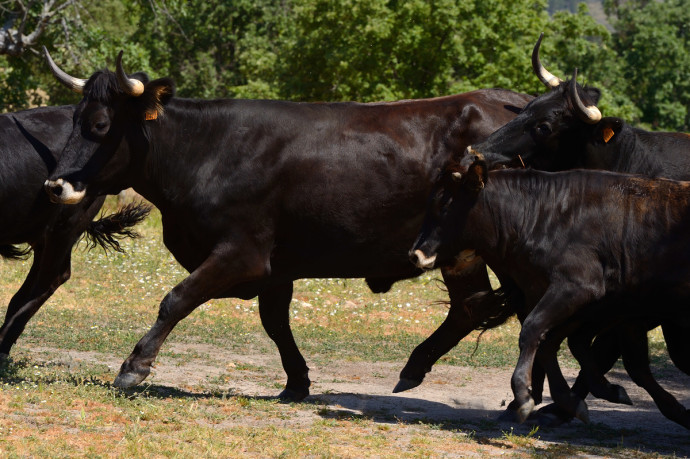Two bulls of the Spanish breed Sayaguesa were transported from The Netherlands in mid October, to become a part of the Tauros Breeding Program in the Velebit mountains, Croatia.

They already seem adapted to their new environment, grazing together with the existing herd of 16 animals of the ancient Croatian breed called Boskarin. Both these breeds are among those identified as among those most close to the original aurochs. Rewilding Europe’s work together with the Tauros Programme, with the goal to bring back the aurochs as a functional wild animal, will soon yield results as most the conditions for a good back-breeding process are now set in the Velebit Mountains.
The Sayaguesa breed
The Sayaguesa is a breed from the Spanish province of Zamora and it preserves a number of features that make it very useful for back-breeding. Sayaguesa bulls are large, weighing around a ton, long-legged and black in colour. They have shared characteristics with the ancestor of all cattle, their horns are aurochs-like and swung forwards, they have the typical white-coloured muzzle of the aurochs and a swung backline which again resembles that of the aurochs. Furthermore, Sayaguesas do not have the short calf-like face of many domestic cattle breeds. In regard to their resistance and behaviour, this breed is known to be hardy, robust and frugal and therefore needs no shelters nor barns, they are used to live outdoors year-round.
The release

That hardiness was evident during the transport, when the trailer from Netherlands arrived at the base of the mountain. The Velebit rewilding team was helped by the workers from the National Park Paklenica together with the director of the National Park Mr. Zlatko Marasović. With combined efforts the bulls were transferred to another truck which drove them, one by one, up the mountain.
The first younger bull arrived to the breeding site during daylight; immediately spotted the Boskarin cattle grazing on the plane, ran out and joined them. The Boskarins, who were scattered around the plane quickly spotted the newcomer and ran towards it, following the bull around the meadow. The second, more robust bull caused a bit more problems, since it first hesitated to enter the new truck and then arriving up at the mountain site quite late at night, hesitated to leave it. The sentence „This is one very angry bull“ was heard many times during that day.
The Rewilding Velebit team visited Malo Libinje last Friday to check out how the bulls have adapted to the new area. „The younger bull is very lively and active. It very quickly joined the Boskarin herd and is grazing with them every day but the older one is keeping to himself and exploring the surroundings,“ said Petar Knezevic, the herd manager. Unfortunately, the team members could not see the animals due to the very strong Bora winds which urged the cattle to migrate to a more protected area, out of sight.
The Tauros Programme
The arrival of these Sayaguesa bulls is an important milestone of the Tauros Programme. In November 2012, Rewilding Europe and the Taurus Foundation signed a long-term agreement about helping to preserve biodiversity in Europe through a breeding programme to bring back a functional, wild version of the aurochs. For hundreds of thousands of years, the aurochs was a keystone species in many European ecosystems, it was heavily hunted already by early man and was finally hunted into extinction as a wild animal in 1627. Around 2025, the Tauros animals are expected to again have the right, fully natural characteristics of the aurochs. By then the animal is also expected to have gained official recognition as a wildlife species and to be released back into the wild in a number of areas, starting off mainly with the areas within the Rewilding Europe initiative. The path of back-breeding is a hard and long one, but the final goal of the programme is the presence of the Tauros as a self-sufficient wild bovine grazer in herds of at least 150 animals each in several rewilding areas in Europe, including the Velebit Mountains.
Read more about the Tauros Programme.
